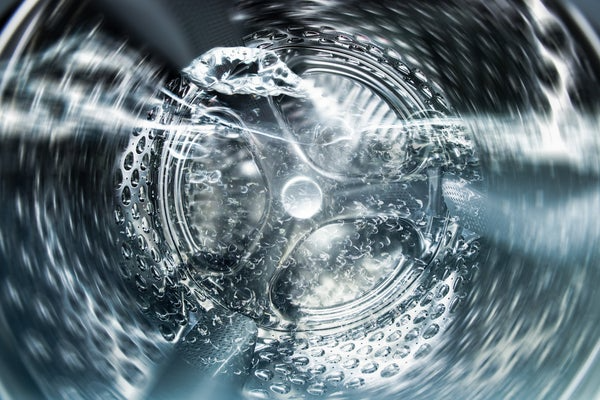Along with stubbing your toe and getting stuck in traffic, a washing machine not draining is one of those seemingly minor things that can ruin an otherwise good day. After all, it’s frustrating when you go to transfer a load of clothes from the washer to the dryer, only to encounter a deluge of water remaining in the washer tub after the cycle has finished.
If your washing machine won’t drain, we’re here to help. Learn more about the function of your washing machine drain and how to drain the washer on your own.
Why Won't My Washing Machine Drain Water?
A washing machine not draining can have multiple causes, including a clogged or jammed drain hose or a broken pump, lid switch, or belt. No matter the culprit, you need to drain the water from the washing machine before diagnosing the issue or doing any work to remedy the situation.
What Does the Drain Function on a Washing Machine Do?
A washing machine’s drain function removes water from the tub during the spin cycle. The washer pump forces water from the bottom of the appliance into the drain hose. The washer drain hose loops to the top of the machine and then down to the drain, enabling the tub to fill. When the water reaches the bend in the hose, it goes out of the drain.
How to Drain a Washing Machine Manually
If your washing machine is not draining completely, the mechanics of draining the water is up to you. Here are a few ways to manually drain the water in your washing machine:
- Bail it out with a bucket: Bailing out the water with a bucket, cup, or bowl is often the go-to strategy for most people who find that their washing machine won’t drain. However, this technique can be time-consuming, tedious, and hard on your back because you have to bend over repeatedly to scoop up water from the bottom of the machine.
- Drain it with a hose: This is an easier way to drain water than bailing it out with a bucket because you’re using the drain hose and letting gravity do the hard work for you. To drain your washer with the washing machine drain hose, you’ll need a bucket, a screwdriver, needle-nose pliers, and a clamp. It’s also a good idea to have a sponge and towels on hand in case of a spill.
Follow these steps to drain the water with the drain hose.
Step 1: Turn off the power.
Make sure that you unplug your washer from the outlet or turn off the power at the circuit breaker or fuse box. You may also want to turn off the hot and cold water connections to the washing machine, just in case.
Step 2: Find the drain hose at the back of the washing machine.
The drain hose resides behind your washer and connects the washing machine to your exterior washing machine drainpipe. If your drain hose is bent or has a kink, it may block the water flow. If this seems to be the issue, simply straighten the hose.
If it does not appear to have a bend or kink, your next step is to disconnect it from the washing machine drain. If necessary, unscrew the hose with a clamp attached. Always keep the hose higher than the washer tub until you’re ready to empty out the water.
Step 3: Set up the bucket and drain hose.
Ensure that the bucket is in a place where you won’t accidentally knock it over; you may want to place it firmly on or between several towels. Then, drop the house lower than the washer tub and into the bucket. If the bucket fills up, simply raise the hose back above the washer tub until you can empty the bucket. Drop the hose to start to fill it again.
If water doesn’t flow freely from the washing machine tub through the drain hose and into the bucket, the filter may be blocked, so you’ll need to clear it before continuing.


